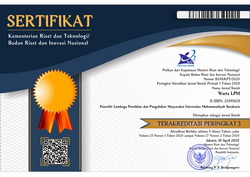Utilization Community-Based Rehabilitation Methods to Improve Independence and Quality of Life for Patients with Disabilities in Nara Phirom Health Promoting Hospital, Thailand
DOI:
https://doi.org/10.23917/warta.v27i2.4782Keywords:
Community-Based Rehabilitation (CBR), independence, quality of life, disabilityAbstract
The disability community activity, Nara Phirom Health Promoting Hospital in Banglen District, Nakhon Pathom, Thailand, collaborated with the Faculty of Physiotherapy, Mahidol University to support the disability community. Using the Community-based rehabilitation (CBR) method, the aim to enhance independence and quality of life. Evaluation includes IADL for independence and WHOQoL Bref-100 for quality of life. Education on health, immobilization, and exercise was provided to patients, families, and caregivers. Therapists teached physical exercises, to be repeated 2-3 times daily by caregivers and family. The 1-month program, supervised by therapists, includes standing and walking for patients with lower extremity strength of 3/5 (measured by manual muscle testing). Rehabilitation involves crafting items like wallets and bags, stamps, and flowers from bottles. Results, patients with low function status (very dependent on other people) decreased by 64.3%, moderate function increased by 116.7% and independence increased by 111.1%. There was a significant improvement in quality of life (WHOQoL) and all domains after CBR program.
Downloads
References
Adaka, A., Florence, O., & Ikwem, E. J. I. J. T. I. E. (2014). Implementation of community-based rehabilitation in Nigeria: the role of family of people with disabilities. 1(2), 420-425.
Association, S. O. o. D. P. I. A., & Organization, W. H. (2002). Community-based rehabilitation as we have experienced it: voices of persons with disabilities in Ghana, Guyana and Nepal. Part 2, Country reports: World Health Organization.
Barker, K. L., Room, J., Knight, R., Dutton, S., Toye, F., Leal, J., . . . Beard, D. J. B. o. (2021). Home-based rehabilitation programme compared with traditional physiotherapy for patients at risk of poor outcome after knee arthroplasty: the CORKA randomised controlled trial. 11(8), e052598.
Barr, A. E., Barbe, M. F., & Clark, B. D. (2004). Work-related musculoskeletal disorders of the hand and wrist: epidemiology, pathophysiology, and sensorimotor changes. J Orthop Sports Phys Ther, 34(10), 610-627. doi:10.2519/jospt.2004.34.10.610
Bongo, P. P., Dziruni, G., & Muzenda-Mudavanhu, C. (2018). The effectiveness of community-based rehabilitation as a strategy for improving quality of life and disaster resilience for children with disability in rural Zimbabwe. Jamba, 10(1), 442. doi:10.4102/jamba.v10i1.442
Butura, A. M., Ryan, G. K., Shakespeare, T., Ogunmola, O., Omobowale, O., Greenley, R., & Eaton, J. (2024). Community-based rehabilitation for people with psychosocial disabilities in low- and middle-income countries: a systematic review of the grey literature. Int J Ment Health Syst, 18(1), 13. doi:10.1186/s13033-024-00630-0
Castillo, E. G., Ijadi-Maghsoodi, R., Shadravan, S., Moore, E., Mensah, M. O., 3rd, Docherty, M., . . . Wells, K. B. (2020). Community Interventions to Promote Mental Health and Social Equity. Focus (Am Psychiatr Publ), 18(1), 60-70. doi:10.1176/appi.focus.18102
Chung, E. Y. (2019). Identifying evidence to define community-based rehabilitation practice in China using a case study approach with multiple embedded case study design. BMC Health Serv Res, 19(1), 6. doi:10.1186/s12913-018-3838-7
Daengthern, L., Thojampa, S., Kumpeera, K., Wannapornsiri, C., & Boonpracom, R. (2020). Factors Affecting Quality of Life and Longevity in the Elderly People in Phrae City, Thailand. Asian Pac Isl Nurs J, 5(2), 48-54. doi:10.31372/20200502.1081
Estoque, R. C., Togawa, T., Ooba, M., Gomi, K., Nakamura, S., Hijioka, Y., & Kameyama, Y. (2019). A review of quality of life (QOL) assessments and indicators: Towards a "QOL-Climate" assessment framework. Ambio, 48(6), 619-638. doi:10.1007/s13280-018-1090-3
Flanagan, S., Damery, S., & Combes, G. (2017). The effectiveness of integrated care interventions in improving patient quality of life (QoL) for patients with chronic conditions. An overview of the systematic review evidence. Health Qual Life Outcomes, 15(1), 188. doi:10.1186/s12955-017-0765-y
Grandisson, M. (2015). Developing Guidelines for Program Evaluation in Community-Based Rehabilitation. Université d'Ottawa/University of Ottawa,
Gréaux, M., Moro, M. F., Kamenov, K., Russell, A. M., Barrett, D., & Cieza, A. (2023). Health equity for persons with disabilities: a global scoping review on barriers and interventions in healthcare services. Int J Equity Health, 22(1), 236. doi:10.1186/s12939-023-02035-w
Keen, C., Hashmi-Greenwood, M., York, J., Armstrong, I. J., Sage, K., & Kiely, D. J. P. c. (2019). Exploring a physiotherapy well-being review to deliver community-based rehabilitation in patients with pulmonary hypertension. 9(4), 2045894019885356.
Lam, C. J. H. o. d. b., & measures, q. o. l. (2010). Subjective quality of life measures–general principles and concepts.
Lawton, M. P., & Brody, E. M. (1969). Assessment of older people: self-maintaining and instrumental activities of daily living. Gerontologist, 9(3), 179-186.
Morgan, K. H., Barroso, C. S., Bateman, S., Dixson, M., & Brown, K. C. (2020). Patients' Experiences of Interprofessional Collaborative Practice in Primary Care: A Scoping Review of the Literature. J Patient Exp, 7(6), 1466-1475. doi:10.1177/2374373520925725
Motamed-Jahromi, M., & Kaveh, M. H. (2020). Effective Interventions on Improving Elderly's Independence in Activity of Daily Living: A Systematic Review and Logic Model. Front Public Health, 8, 516151. doi:10.3389/fpubh.2020.516151
Rahayu, U. B., & Ambarwati, A. (2021). PKM Edukasi dan Neurorestorasi pada Pasien Pasca Stroke di Praktik Fisioterapi Mj_9 Fisioterapi Center. Warta LPM, 24(1), 1-10.
Sandjojo, J., Gebhardt, W. A., Zedlitz, A. M., Hoekman, J., den Haan, J. A., Evers, A. W. J. J. o. P., & Disabilities, P. i. I. (2019). Promoting independence of people with intellectual disabilities: A focus group study perspectives from people with intellectual disabilities, legal representatives, and support staff. 16(1), 37-52.
Umunnah, J., Adegoke, B., Uchenwoke, C., Igwesi-Chidobe, C., & Alom, G. J. G. H. J. (2023). Impact of community-based rehabilitation on quality of life and self-esteem of persons with physical disabilities and their family members.
UNDESA. (2019). World Population Ageing 2019. https://www.un.org/en/development/desa/population/publications/pdf/ageing/WorldPopulationAgeing2019-Highlights.pdf
UNDESA. (2021). Disability and Social Inclusion. https://www.un.org/development/desa/disabilities/disability-and-social-inclusion.html
Wehmeyer, M. L. J. I. J. o. E. R., & Health, P. (2020). The importance of self-determination to the quality of life of people with intellectual disability: A perspective. 17(19), 7121.
WHO. (2010). WHO Guidelines Approved by the Guidelines Review Committee. In C. Khasnabis, K. Heinicke Motsch, K. Achu, K. Al Jubah, S. Brodtkorb, P. Chervin, P. Coleridge, M. Davies, S. Deepak, K. Eklindh, A. Goerdt, C. Greer, K. Heinicke-Motsch, D. Hooper, V. B. Ilagan, N. Jessup, C. Khasnabis, D. Mulligan, B. Murray, A. Officer, F. Ortali, B. Ransom, A. Robert, S. Stubbs, M. Thomas, V. Balakrishna, R. Wabuge-Mwangi, N. Mattock, & T. Lander (Eds.), Community-Based Rehabilitation: CBR Guidelines. Geneva: World Health Organization. Copyright © World Health Organization 2010.
WHO. (2019). Disability and Health: Features. https://www.cdc.gov/ncbddd/disabilityandhealth/features/disability-impacts-all.html
WHO. (2020a). Disability: People with disability vs persons with disabilities. People with disability” vs “persons with disabilities.
WHO. (2020b). WHOQOL: Measuring Quality of Life. Indonesian_WHOQOL-BREF. https://www.who.int/tools/whoqol/whoqol-bref/docs/default-source/publishing-policies/whoqol-bref/indonesian-whoqol-bref
Witt Sherman, D., Flowers, M., Alfano, A. R., Alfonso, F., De Los Santos, M., Evans, H., . . . Walsh, S. (2020). An Integrative Review of Interprofessional Collaboration in Health Care: Building the Case for University Support and Resources and Faculty Engagement. Healthcare (Basel), 8(4). doi:10.3390/healthcare8040418
Yahya, A. T., Surajo, A. Z., Musa, J. J. J. o. R. T., & Vol, E. D. (2018). Community-based rehabilitation programmes in Kano State, Nigeria: an inclusive and integrated approach for sustainable national development. 1(1).
Downloads
Submitted
Accepted
Published
How to Cite
Issue
Section
License
Copyright (c) 2024 Warta LPM

This work is licensed under a Creative Commons Attribution 4.0 International License.














